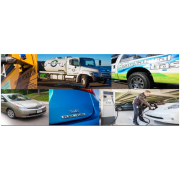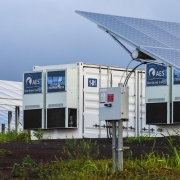Propane Moving In A Greener Direction
written by Kansas City Regional Clean Cities Coalition director David Albrecht
![]() It’s probably an overstatement to call propane America’s most overlooked fuel. That said, it does kind of fly under the radar. For many of us, our only interaction with it comes when replacing a cylinder for the barbeque grill. But beyond the bottle cage at Lowe’s, and once you leave the city, propane is ubiquitous. In America, if you’re in the country, you’re in propane country. 83% of all households that heat with propane are in rural areas. In the rural Midwest, it’s close to 90%. Propane is affordable and easy to purchase and use, thanks to a well-developed supplier network.
It’s probably an overstatement to call propane America’s most overlooked fuel. That said, it does kind of fly under the radar. For many of us, our only interaction with it comes when replacing a cylinder for the barbeque grill. But beyond the bottle cage at Lowe’s, and once you leave the city, propane is ubiquitous. In America, if you’re in the country, you’re in propane country. 83% of all households that heat with propane are in rural areas. In the rural Midwest, it’s close to 90%. Propane is affordable and easy to purchase and use, thanks to a well-developed supplier network.
Part of oil and gas formations, propane is one of the natural gas liquids (NGLs) along with butane, pentane and a few more. During oil and gas production, NGLs come hissing to the surface, mixed with natural gas. They’re then separated during refining and sold as feedstocks for plastics, solvents, and (in the case of propane) for heating and fuel. They are a small slice of the global oil and natural gas market, about 14% of output. But as fracking has boomed in the past decade, nearly doubling American propane production, more auto manufacturers and fleet managers are taking another look at propane-powered vehicles.
Propane Power
Like any fuel, propane has its pluses and minuses for transportation. Propane is less energetic than either gasoline or diesel. You would have to use 1.38 gallons of propane to match the energy of a gallon of gasoline, and 1.52 gallons to equal a gallon of diesel. The flip side is that propane is cheap – it typically costs about 30% less than gasoline and 50% less than diesel fuel. It’s also far cleaner than diesel, producing far less in the way of smog-forming chemicals. This means that many components of diesel emissions control systems – DPF regeneration, diesel oxidation catalyst, selective catalytic reduction, diesel emissions fluid – are eliminated by switching to propane. Diesel emission controls work, but they also make for complicated, expensive maintenance.
But in the end, there’s still an impact. Propane is still a fossil fuel, and still part of the big global machine that produces oil and gas, and also pumps ever-more carbon into the atmosphere. Or at least it was a fossil fuel, until now.
The Renewable Difference
What’s new? Renewable propane. It’s chemically identical to fossil propane, but produces between 60% and 70% less carbon when used.
Renewable propane and diesel have some things in common with biodiesel. All three can be made from the same renewable feedstocks, like corn oil, soybean oil, tallow and waste grease. But the methods to produce these fuels are very different. You can make biodiesel at low temperatures and at small scale, in laboratories or classrooms – there’s even a user’s guide for high school students interested in biodiesel. But renewable diesel and renewable propane come from refineries, produced by some of the same processes as fossil fuels. They’re chemically identical to their petroleum versions, and have the same properties.
As a clean-burning, low-carbon fuel produced from renewable feedstocks, there’s a lot to like about renewable propane. This is especially true in major markets like California. There, tough clean air standards give cleaner-burning fuel an edge over conventional options, and clean fuel credits can sweeten the financial picture for users. Today renewable propane only accounts for somewhere between 1% and 2% of all propane output. But prospects for rapid growth of this lower-carbon and completely renewable energy source seem bright.



 Photo by: Anissa Parra-Grooms, Metropolitan Energy Center
Photo by: Anissa Parra-Grooms, Metropolitan Energy Center 



